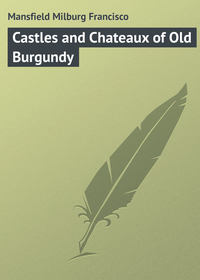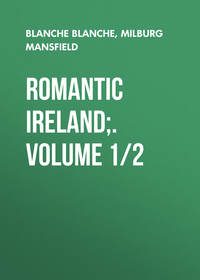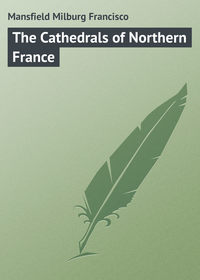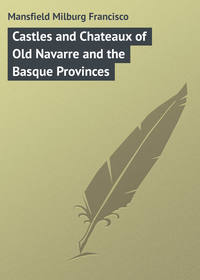 полная версия
полная версияThe Cathedrals of Southern France

Mansfield M. F. Milburg Francisco
The Cathedrals of Southern France
TOO often – it is a half-acknowledged delusion, however – one meets with what appears to be a theory: that a book of travel must necessarily be a series of dull, discursive, and entirely uncorroborated opinions of one who may not be even an intelligent observer. This is mere intellectual pretence. Even a humble author – so long as he be an honest one – may well be allowed to claim with Mr. Howells the right to be serious, or the reverse, "with his material as he finds it;" and that "something personally experienced can only be realized on the spot where it was lived." This, says he, is "the prime use of travel, and the attempt to create the reader a partner in the enterprise" … must be the excuse, then, for putting one's observations on paper.
He rightly says, too, that nothing of perilous adventure is to-day any more like to happen "in Florence than in Fitchburg."
A "literary tour," a "cathedral tour," or an "architectural tour," requires a formula wherein the author must be wary of making questionable estimates; but he may, with regard to generalities, – or details, for that matter, – state his opinion plainly; but he should state also his reasons. With respect to church architecture no average reader, any more than the average observer, willingly enters the arena of intellectual combat, but rather is satisfied – as he should be, unless he is a Freeman, a Gonse, or a Corroyer – with an ampler radius which shall command even a juster, though no less truthful, view.
Not from one book or from ten, in one year or a score can this be had. The field is vast and the immensity of it all only dawns upon one the deeper he gets into his subject. A dictionary of architecture, a compendium or gazetteer of geography, or even the unwieldy mass of fact tightly held in the fastnesses of the Encyclopædia Britannica will not tell one – in either a long or a short while – all the facts concerning the cathedrals of France.
Some will consider that in this book are made many apparently trifling assertions; but it is claimed that they are pertinent and again are expressive of an emotion which mayhap always arises of the same mood.
Notre Dame at Rodez is a "warm, mouse-coloured cathedral;" St. Cécile d'Albi is at once "a fortress and a church," and the once royal city of Aigues-Mortes is to-day but "a shelter for a few hundred pallid, shaking mortals."
Such expressions are figurative, but, so far as words can put it, they are the concentrated result of observation.
These observations do not aspire to be considered "improving," though it is asserted that they are informative.
Description of all kinds is an art which requires considerable forethought in order to be even readable. And of all subjects, art and architecture are perhaps the most difficult to treat in a manner which shall not arouse an intolerant criticism.
Perhaps some credit will be attained for the attempts herein made to present in a pleasing manner many of the charms of the ecclesiastical architecture of southern France, where a more elaborate and erudite work would fail of its object. As Lady Montagu has said in her "Letters," – "We travellers are in very hard circumstances. If we say nothing new, we are dull, and have observed nothing. If we tell any new thing, we are laughed at as fabulous and romantic."
This book is intended as a contribution to travel literature – or, if the reader like, to that special class of book which appeals largely to the traveller.
Most lovers of art and literature are lovers of churches; indeed, the world is yearly containing more and more of this class. The art expression of a people, of France in particular, has most often first found its outlet in church-building and decoration. Some other countries have degenerated sadly from the idea.
In recent times the Anglo-Saxon has mostly built his churches, – on what he is pleased to think are "improved lines," – that, more than anything else, resemble, in their interiors, playhouses, and in their exteriors, cotton factories and breweries.
This seemingly bitter view is advanced simply because the writer believes that it is the church-members, using the term in its broad sense, who are responsible for the many outrageously unseemly church-buildings which are yearly being erected; not the architects – who have failings enough of their own to answer for.
It is said that a certain great architect of recent times was responsible for more bad architecture than any man who had lived before or since. Not because he produced such himself, but because his feeble imitators, without his knowledge, his training, or his ambition, not only sought to follow in his footsteps, but remained a long way in the rear, and stumbled by the way.
This man built churches. He built one, Trinity Church, in Boston, U. S. A., which will remain, as long as its stones endure, an entirely successful transplantation of an exotic from another land. In London a new Roman Catholic cathedral has recently been erected after the Byzantine manner, and so unexpectedly successful was it in plan and execution that its author was "medalled" by the Royal Academy; whatever that dubious honour may be worth.
Both these great men are dead, and aside from these two great examples, and possibly the Roman Catholic cathedral, and the yet unachieved cathedral of St. John the Divine, in New York City, where, in an English-speaking land, has there been built, in recent times, a religious edifice of the first rank worthy to be classed with these two old-world and new-world examples?
They do these things better in France: Viollet-le-Duc completed St. Ouen at Rouen and the cathedral at Clermont-Ferrand, in most acceptable manner. So, too, was the treatment of the cathedral at Moulins-sur-Allier – although none of these examples are among the noblest or the most magnificent in France. They have, however, been completed successfully, and in the true spirit of the original.
To know the shops and boulevards of Paris does not necessarily presume a knowledge of France. This point is mentioned here from the fact that many have claimed a familiarity with the cathedrals of France; when to all practical purposes, they might as well have begun and ended with the observation that Notre Dame de Paris stands on an island in the middle of the Seine.
The author would not carp at the critics of the first volume of this series, which appeared last season. Far from it. They were, almost without exception, most generous. At least they granted, unqualifiedly, the reason for being for the volume which was put forth bearing the title: "Cathedrals of Northern France."
The seeming magnitude of the undertaking first came upon the author and artist while preparing the first volume for the press. This was made the more apparent when, on a certain occasion, just previous to the appearance of the book, the author made mention thereof to a friend who did know Paris – better perhaps than most English or American writers; at least he ought to have known it better.
When this friend heard of the inception of this book on French cathedrals, he marvelled at the fact that there should be a demand for such; said that the subject had already been overdone; and much more of the same sort; and that only yesterday a certain Miss – had sent him an "author's copy" of a book which recounted the results of a journey which she and her mother had recently made in what she sentimentally called "Romantic Touraine."
Therein were treated at least a good half-dozen cathedrals; which, supplementing the always useful Baedeker or Joanne, and a handbook of Notre Dame at Paris and another of Rouen, covered – thought the author's friend at least – quite a representative share of the cathedrals of France.
This only substantiates the contention made in the foreword to the first volume: that there were doubtless many with a true appreciation and love for great churches who would be glad to know more of them, and have the ways – if not the means – smoothed in order to make a visit thereto the more simplified and agreeable. Too often – the preface continued – the tourist, alone or personally conducted in droves, was whirled rapidly onward by express-train to some more popularly or fashionably famous spot, where, for a previously stipulated sum, he might partake of a more lurid series of amusements than a mere dull round of churches.
"Cities, like individuals, have," says Arthur Symons, "a personality and individuality quite like human beings."
This is undoubtedly true of churches as well, and the sympathetic observer – the enthusiastic lover of churches for their peculiarities, none the less than their general excellencies – is the only person who will derive the maximum amount of pleasure and profit from an intimacy therewith.
Whether a great church is interesting because of its antiquity, its history, or its artistic beauties matters little to the enthusiast. He will drink his fill of what offers. Occasionally, he will find a combination of two – or possibly all – of these ingredients; when his joy will be great.
Herein are catalogued as many of the attributes of the cathedrals of the south of France – and the records of religious or civil life which have surrounded them in the past – as space and opportunity for observation have permitted.
More the most sanguine and capable of authors could not promise, and while in no sense does the volume presume to supply exhaustive information, it is claimed that all of the churches included within the classification of cathedrals – those of the present and those of a past day – are to be found mentioned herein, the chief facts of their history recorded, and their notable features catalogued.
PART I
Southern France in General
I
THE CHARM OF SOUTHERN FRANCE
The charm of southern France is such as to compel most writers thereon to become discursive. It could not well be otherwise. Many things go to make up pictures of travel, which the most polished writer could not ignore unless he confined himself to narrative pure and simple; as did Sterne.
One who seeks knowledge of the architecture of southern France should perforce know something of the life of town and country in addition to a specific knowledge of, or an immeasurable enthusiasm for, the subject.
Few have given Robert Louis Stevenson any great preëminence as a writer of topographical description; perhaps not all have admitted his ability as an unassailable critic; but the fact is, there is no writer to whom the lover of France can turn with more pleasure and profit than Stevenson.
There is a wealth of description of the country-side of France in the account of his romantic travels on donkey-back, or, as he whimsically puts it, "beside a donkey," and his venturesome though not dangerous "Inland Voyage." These early volumes of Stevenson, while doubtless well known to lovers of his works, are closed books to most casual travellers. The author and artist of this book here humbly acknowledge an indebtedness which might not otherwise be possible to repay.
Stevenson was devout, he wrote sympathetically of churches, of cathedrals, of monasteries, and of religion. What his predilections were as to creed is not so certain. Sterne was more worldly, but he wrote equally attractive prose concerning many things which English-speaking people have come to know more of since his time. Arthur Young, "an agriculturist," as he has been rather contemptuously called, a century or more ago wrote of rural France after a manner, and with a profuseness, which few have since equalled. His creed, likewise, appears to be unknown; in that, seldom, if ever, did he mention churches, and not at any time did he discuss religion.
In a later day Miss M. E. B. Edwards, an English lady who knows France as few of her countrywomen do, wrote of many things more or less allied with religion, which the ordinary "travel books" ignored – much to their loss – altogether.
Still more recently another English lady, Madam Marie Duclaux, – though her name would not appear to indicate her nationality, – has written a most charming series of observations on her adopted land; wherein the peasant, his religion, and his aims in life are dealt with more understandingly than were perhaps possible, had the author not been possessed of a long residence among them.
Henry James, of all latter-day writers, has given us perhaps the most illuminating accounts of the architectural joy of great churches, châteaux and cathedrals. Certainly his work is marvellously appreciative, and his "Little Tour in France," with the two books of Stevenson before mentioned, Sterne's "Sentimental Journey," – and Mr. Tristram Shandy, too, if the reader likes, – form a quintette of voices which will tell more of the glories of France and her peoples than any other five books in the English language.
When considering the literature of place, one must not overlook the fair land of Provence or the "Midi of France" – that little-known land lying immediately to the westward of Marseilles, which is seldom or never even tasted by the hungry tourist.
To know what he would of these two delightful regions one should read Thomas Janvier, Félix Gras, and Mêrimêe. He will then have far more of an insight into the places and the peoples than if he perused whole shelves of histories, geographies, or technical works on archæology and fossil remains.
If he can supplement all this with travel, or, better yet, take them hand-in-hand, he will be all the more fortunate.
At all events here is a vast subject for the sated traveller to grasp, and en passant he will absorb not a little of the spirit of other days and of past history, and something of the attitude of reverence for church architecture which is apparently born in every Frenchman, – at least to a far greater degree than in any other nationality, – whatever may be his present-day attitude of mind toward the subject of religion in the abstract.
France, be it remembered, is not to-day as it was a century and a half ago, when it was the fashion of English writers to condemn and revile it as a nation of degraded serfs, a degenerate aristocracy, a corrupt clergy, or as an enfeebled monarchy.
Since then there has arisen a Napoleon, who, whatever his faulty morals may have been, undoubtedly welded into a united whole those widely divergent tendencies and sentiments of the past, which otherwise would not have survived. This was prophetic and far-seeing, no matter what the average historian may say to the contrary; and it has in no small way worked itself toward an ideal successfully, if not always by the most practical and direct path.
One thing is certain, the lover of churches will make the round of the southern cathedrals under considerably more novel and entrancing conditions than in those cities of the north or mid-France. Many of the places which shelter a great cathedral church in the south are of little rank as centres of population; as, for instance, at Mende in Lozère, where one suddenly finds oneself set down in the midst of a green basin surrounded by mountains on all sides, with little to distract his attention from its remarkably picturesque cathedral; or at Albi, where a Sunday-like stillness always seems to reign, and its fortress-church, which seems to regulate the very life of the town, stands, as it has since its foundation, a majestic guardian of well-being.
There is but one uncomfortable feature to guard against, and that is the mistral, a wind which blows down the Rhône valley at certain seasons of the year, and, in the words of the habitant, "blows all before it." It is not really as bad as this, but its breath is uncomfortably cold, and it does require a firm purpose to stand against its blast.
Then, too, from October until March, south of Lyons, the nights, which draw in so early at this season of the year, are contrastingly and uncomfortably cold, as compared with the days, which seem always to be blessed with bright and sunshiny weather.
It may be argued that this is not the season which appeals to most people as being suitable for travelling. But why not? Certainly it is the fashion to travel toward the Mediterranean during the winter months, and the attractions, not omitting the allurements of dress clothes, gambling-houses, and bals masqués are surely not more appealing than the chain of cities which extend from Chambéry and Grenoble in the Alps, through Orange, Nîmes, Arles, Perpignan, Carcassonne, and the slopes of the Pyrenees, to Bayonne.
In the departments of Lozère, Puy de Dôme, Gard and Auvergne and Dordogne, the true, unspoiled Gallic flavour abides in all its intensity. As Touraine, or at least Tours, claims to speak the purest French tongue, so this region of streams and mountains, of volcanic remains, of Protestantism, and of an – as yet – unspoiled old-worldliness, possesses more than any other somewhat of the old-time social independence and disregard of latter-day innovations.
Particularly is this so – though perhaps it has been remarked before – in that territory which lies between Clermont-Ferrand and Valence in one direction, and Vienne and Rodez in another, to extend its confines to extreme limits.
Here life goes on gaily and in animated fashion, in a hundred dignified and picturesque old towns, and the wise traveller will go a-hunting after those which the guide-books complain of – not without a sneer – as being dull and desultory. French, and for that matter the new régime of English, historical novelists are too obstinately bent on the study of Paris, "At all events," says Edmund Gosse, "since the days of Balzac and George Sand, and have neglected the provincial boroughs."
They should study mid-France on the spot; and read Stevenson and Mérimée while they are doing it. It will save them a deal of worrying out of things – with possibly wrong deductions – for themselves.
The climatic conditions of France vary greatly. From the gray, wind-blown shores of Brittany, where for quite three months of the autumn one is in a perpetual drizzle, and the equally chilly and bare country of the Pas de Calais, and the more or less sodden French Flanders, to the brisk, sunny climate of the Loire valley, the Cevennes, Dauphiné, and Savoie, is a wide range of contrast. Each is possessed of its own peculiar characteristics, which the habitant alone seems to understand in all its vagaries. At all events, there is no part of France which actually merits the opprobrious deprecations which are occasionally launched forth by the residents of the "garden spot of England," who see no topographical beauties save in their own wealds and downs.
France is distinctly a self-contained land. Its tillers of the soil, be they mere agriculturists or workers in the vineyards, are of a race as devoted and capable at their avocations as any alive.
They do not, to be sure, eat meat three times a day – and often not once a week – but they thrive and gain strength on what many an English-speaking labourer would consider but a mere snack.
Again, the French peasant is not, like the English labourer, perpetually reminded, by the independence of the wealth surrounding him, of his own privations and dependence. On the contrary, he enjoys contentment with a consciousness that no human intervention embitters his condition, and that its limits are only fixed by the bounds of nature, and somewhat by his own industry.
Thus it is easy to inculcate in such a people somewhat more of that spirit of "l'amour de la patrie," or love of the land, which in England, at the present time, appears to be growing beautifully less.
So, too, with love and honour for their famous citizens, the French are enthusiastic, beyond any other peoples, for their monuments, their institutions, and above all for their own province and department.
With regard to their architectural monuments, still more are they proud and well-informed, even the labouring classes. Seldom, if ever, has the writer made an inquiry but what it was answered with interest, if not with a superlative intelligence, and the Frenchman of the lower classes – be he a labourer of the towns or cities, or a peasant of the country-side – is a remarkably obliging person.
In what may strictly be called the south of France, that region bordering along the Mediterranean, Provence, and the southerly portion of Languedoc, one is manifestly environed with a mellowness and brilliance of sky and atmosphere only to be noted in a sub-tropical land, a feature which finds further expression in most of the attributes of local life.
The climate and topographical features take on a contrastingly different aspect, as does the church architecture and the mode of life of the inhabitants here in the southland.
Here is the true romance country of all the world. Here the Provençal tongue and its literature have preserved that which is fast fleeting from us in these days when a nation's greatest struggle is for commercial or political supremacy. It was different in the days of Petrarch and of Rabelais.
But there are reminders of this glorious past yet to be seen, more tangible than a memory alone, and more satisfying than mere written history.
At Orange, Nîmes, and Arles are Roman remains of theatres, arenas, and temples, often perfectly preserved, and as magnificent as in Rome itself.
At Avignon is a splendid papal palace, to which the Holy See was transferred by Clement V. at the time of the Italian partition, in the early fourteenth century, while Laura's tomb, or the site of it, is also close at hand.
At Clermont-Ferrand, in Auvergne, Pope Urban, whose monument is on the spot, urged and instigated the Crusades.
The Christian activities of this land were as strenuous as any, and their remains are even more numerous and interesting. Southern Gaul, however, became modernized but slowly, and the influences of the Christian spirit were not perhaps as rapid as in the north, where Roman sway was more speedily annulled. Still, not even in the churches of Lombardy or Tuscany are there more strong evidences of the inception and growth of this great power, which sought at one time to rule the world, and may yet.
II
THE CHURCH IN GAUL
Guizot's notable dictum, "If you are fond of romance and history," may well be paraphrased in this wise: "If you are fond of history, read the life histories of great churches."
Leaving dogmatic theory aside, much, if not quite all, of the life of the times in France – up to the end of the sixteenth century – centred more or less upon the Church, using the word in its fullest sense. Aside from its religious significance, the influence of the Church, as is well known and recognized by all, was variously political, social, and perhaps economic.
So crowded and varied were the events of Church history in Gaul, it would be impossible to include even the most important of them in a brief chronological arrangement which should form a part of a book such as this.
It is imperative, however, that such as are mentioned should be brought together in some consecutive manner in a way that should indicate the mighty ebb and flow of religious events of Church and State.
These passed rapidly and consecutively throughout Southern Gaul, which became a part of the kingdom of the French but slowly.
Many bishoprics have been suppressed or merged into others, and again united with these sees from which they had been separated. Whatever may be the influences of the Church, monastic establishments, or more particularly, the bishops and their clergy, to-day, there is no question but that from the evangelization of Gaul to the end of the nineteenth century, the parts played by them were factors as great as any other in coagulating and welding together the kingdom of France.
The very large number of bishops which France has had approximates eight thousand eminent and virtuous names; and it is to the memory of their works in a practical way, none the less than their devotion to preaching the Word itself, that the large number of magnificent ecclesiastical monuments have been left as their heritage.
There is a large share of veneration and respect due these pioneers of Christianity; far more, perhaps, than obtains for those of any other land. Here their activities were so very great, their woes and troubles so very oppressive, and their final achievement so splendid, that the record is one which stands alone.









